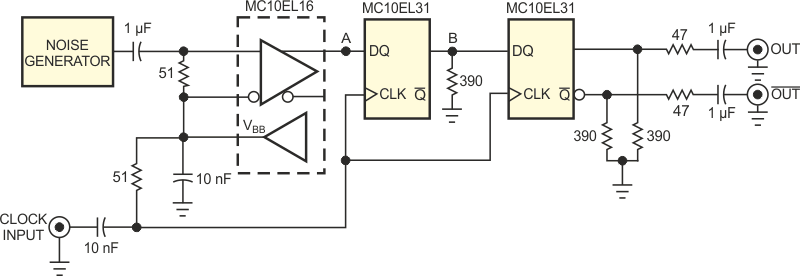A random-bit-sequence generator is basic equipment for prototyping and testing any data-transmission system. You use such a generator when measuring BER (bit-error rate) and pattern-dependent effects in a transmission system. Such effects can include baseline wander, pattern-dependent data jitter, and recovered-clock jitter. Most sequence generators yield a PRBS (pseudorandom bit sequence) from a shift register with appropriate feedback. Thus, the sequence has limited length, and the generator continuously repeats the same pattern. The generator in Figure 1 overcomes these limitations by using random noise to form the outgoing data stream. The circuit uses the ECLinPS logic family. The MC10EL16 liner receiver converts the incoming noise to a digital signal. Next, a rising clock edge of the first MC10EL31 flip-flop samples this random signal. Ideally, this flip-flop should provide a random bit sequence.
 |
||
| Figure 1. | This generator produces truly random bit sequences at frequencies to 1 GHz. | |
Unfortunately, when the data at the flip-flop's input changes simultaneously with the clock's rising edge, the flip-flop may fall into a metastable state. Thus, the resulting output state is indeterminate, and a significantly extended propagation delay may result, producing a jitter in the generated bit sequence. The second MC10EL31 flip-flop eliminates the jitter problem. We tested the generator with clock frequencies to 1 GHz and observed no anomalies in the output eye pattern or frequency spectrum. Note that the ECLinPS devices are ultrafast ICs, so you need to exercise special care in your pc-board design. You should terminate the generator's inputs and outputs with 50 Ω, keep all connections short, and decouple all ICs with local capacitors. You can use a circuit from Reference 1 for a noise source. The voltage of the noise source should be 100 mV to 1 V rms, and its frequency spectrum should be at least equal to the clock frequency.
Reference
- Sliwczynski, Lukasz, “Zener diode and MMICs produce true broadband noise”